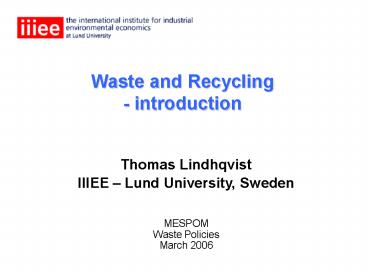Waste and Recycling introduction - PowerPoint PPT Presentation
1 / 40
Title:
Waste and Recycling introduction
Description:
Article 1(a) European Council Directive 75/442/EEC. amended by ... Article 2. For the purposes of this Convention: ... Article 1 ... – PowerPoint PPT presentation
Number of Views:136
Avg rating:3.0/5.0
Title: Waste and Recycling introduction
1
Waste and Recycling - introduction
Thomas Lindhqvist IIIEE Lund University,
Sweden MESPOM Waste Policies March 2006
2
WASTE
- to waste something
- solid waste
- waste water
3
Waste Definitions
4
Waste Definition
- European Union
- Waste shall mean any substance or object in the
categories set out in Annex 1, which the holder
discards or intends or is required to discard. - Article 1(a) European Council Directive
75/442/EEC - amended by
- European Council Directive 91/156/EEC
5
Waste Definition
- Netherlands
- Waste substances all substances, preparations or
other products, which the holder thereof
discards, intends to discard or must discard with
a view to their disposal. - Article 1.1.1 of the Environment Management Act
6
Waste Definition
- Czech Republic
- Waste is a movable object which has become
dispensable to its owner and is discarded with
the intention of disposal, or which is discarded
according to a particular legal requirement. The
objects which are considered wastes under further
determined conditions are listed in Appendix 1 to
the Act. - Section 2 of the Waste Management Act (No.
125/1997 Coll.)
7
Waste Definition
- Switzerland
- wastes are movable things which the owner
discards or whose disposal is in the public
interest - Fedral Law for Protection of the Environment
8
Hazardous Waste Basel Convention on the Control
of Transboundary Movements of Hazardous Wastes
and Their Disposal (1989)
- Article 2
- For the purposes of this Convention
- 1. "Wastes" are substances or objects which are
disposed of or are intended to be disposed of or
are required to be disposed of by the provisions
of national law
9
Waste Types and Quantities
10
MSW - Municipal Solid Waste(household
waste)Industrial WastesHazardous
Wastes(toxic wastes)
11
Hazardous Waste - Basel Convention on the
Control of Transboundary Movements of Hazardous
Wastes and Their Disposal (1989)
- Article 1
- 1. The following wastes that are subject to
transboundary movement shall be "hazardous
wastes" for the purposes of this Convention - (a) Wastes that belong to any category contained
in Annex I, unless they do not possess any of the
characteristics contained in Annex III and - (b) Wastes that are not covered under paragraph
(a) but are defined as, or are considered to be,
hazardous wastes by the domestic legislation of
the Party of export, import or transit.
12
WASTE - quantitiesNote! Available statistics
are often poor and definitions differ.
Sweden MSW 4 Mtons Non-branch
specificindustrial waste 4
Mtons Construction and demolition waste 8
Mtons Industrial wastes 70 Mtons
13
European Union waste amounts
14
Household Waste - quantitiesNote! Available
statistics are poor and definitions differ.
Per-capita Waste Generation Sweden 470
kg Typical EU 400-500 kg USA 760
kg Japan 430 kg City in dev.
country 150-350 kg Rural area dev. country
0 kg
15
MSW - composition
16
DURABLESNON-DURABLES
Newspapers, diapers, disposable tableware,
telephone books, etc.
17
THERMOPLASTICS
PP - polypropylenePS - polystyrenePE -
polyethylene (HDPE,LDPE)PET - polyethylene
terephtalatePVC - polyvinyl chloridePC -
polycarbonate
THERMOSETS
PU - polyurethane
18
Waste Treatment
19
Process diagram
Generation
Transport
Collection
Re-use
Separation
Recycling
Treatment
Anaerobic digestion
Composting
Incineration
Gas cleaning
Energy recovery
Gas- recovery/energy
Filling/land reclamation
Landfilling
Leachate treatment
Gas- recovery/energy
20
LITTERING
21
Landfill
- rodents, insects, birds, etc.
- windblown debris
- odours
- fires
- explosions (methane CH4)
22
(No Transcript)
23
WASTE INCINERATION
- Incineration - combustion - burning
- Waste-to-energy steam and electricity
- Volume reduction - 10 remains
- Weight reduction - 25 remains
- bottom ash (residual ash) - fly ash
- Air emissions
- CO2
- HCl, NOX, SO2
- Hg, Cd
- chlorinated hydrocarbons (dioxins, etc.)
24
Incineration and acidification
HCl if chlorine is present sources? SO2 if
sulphur is present NOX always! why?
25
Chlorine
HCl acidifying Chlorinated (halogenated)
hydrocarbons - dioxins, etc. Sources? How to
mitigate? Br - Bromine (brominated)
26
Heavy metals
Hg sources? Cd sources? Pb sources? Etc.
How can we deal with these substances?
27
Impacts from waste treatment
28
Composting
Biodegradability
aerobic (CO2) anaerobic (CH4 - methane)
fertiliser soil conditioner
29
(No Transcript)
30
(No Transcript)
31
(No Transcript)
32
(No Transcript)
33
(No Transcript)
34
NIMBY
Not in My Backyard
35
HAZARDOUS WASTES(toxic wastes)
- physical treatment
- chemical treatment
- biological treatment
36
Source-separationKerbside (curbside) collection
Collection truckRecycling centreDrop-off
centreBuy-back centre
37
RecyclingRecoveryRe-useVirgin
materialRecycled materialPost-consumer
38
Single-useThrowawayRecyclableRe-usableRefill
able
39
Waste hierarchy
40
Main options for future waste approaches in the
European context
- Avoid landfilling by
- Maximise incineration - recycling for
selected materials - Maximise material recycling and
biological treatment (composting) - Important to work on prevention and sorting out
household hazardous waste































